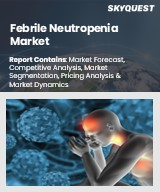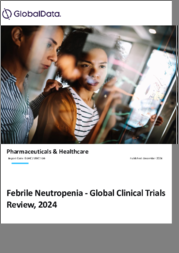
|
시장보고서
상품코드
1485257
세계의 호중구 감소증 치료 시장 규모 : 치료 유형별, 약제 유형별, 투여 경로별, 적응증별, 유통 채널별 예측(2024-2032년)Neutropenia Treatment Market Size - By Treatment Type, Drug Type, Route of Administration, Indication, Distribution Channel, Global Forecast, 2024 - 2032 |
||||||
호중구감소증 치료시장은 암, 자가면역질환, 감염증 등 호중구감소증을 동반하는 경우가 많은 질환의 유병률 증가에 견인되어 2024년부터 2032년에 걸쳐 CAGR 4.1% 이상으로 성장할 것으로 예측됩니다.
WHO에 따르면 2022년에 새로 암으로 진단받은 환자는 약 2,000만명, 사망자수는 970만명이었습니다. 이러한 기본 질환의 이환율이 세계적으로 상승하고 있기 때문에 호중구감소증의 치료를 필요로 하는 환자수도 상당히 증가하고 있습니다. 또한 의료기술과 의약품 개발의 진보로 효능과 안전성 프로파일이 개선된 새로운 치료법과 치료방법이 도입되고 있습니다.
노인들은 노화에 따른 면역계의 변화와 만성질환의 유병률이 높아 호중구감소증에 걸리기 쉽고 호중구감소증 치료에 대한 수요가 높아지고 있습니다. 또한 호중구감소증의 조기 발견과 관리의 중요성에 대한 의식이 높아지면 의료 서비스와 진단에 대한 접근성 향상과 함께 환자의 진단률과 치료를 추구하는 행동을 촉진할 것입니다.
호중구 감소증 치료 시장은 치료 유형, 약물 유형, 투여 경로, 적응증, 유통 채널, 지역으로 구분됩니다.
적응증별로는 특발성 호중구감소증이 2024-2032년의 CAGR 4%로 업계를 견인할 것으로 예상되며 원인을 확인할 수 없는 호중구 수의 감소를 특징으로 합니다. 근본 원인을 알 수 없기 때문에 감염의 위험을 줄이고 환자의 QOL을 향상시키는 증상 관리와 지원 요법이 중요합니다. 또한, 의학 연구와 면역계의 이해의 진보에 의해 특발성 호중구감소증을 효과적으로 관리할 것으로 기대되는 표적 치료제나 면역조절제가 개발되고 있습니다.
약제유형별로 보면, 바이오시밀러 의약품은 선발품의 생물학적 제제를 대체하는 비용 효율적인 대체품을 제공하기 때문에 2024년부터 2032년에 걸쳐 호중구감소증 치료 시장의 CAGR 는 4.8%가 될 것으로 예상됩니다. 세계 건강 관리 시스템이 환자의 케어를 손상시키지 않고 비용을 억제하려고 시도하는 동안 바이오 시밀러 의약품의 저렴한 가격과 가용성이 호중구 감소증 치료 계획에 대한 바이오 시밀러 의약품의 채용을 촉진하고 있습니다. 또한, 바이오시밀러 의약품은 기준 생물학적 제제와 동등한 효능 및 안전성 프로파일을 입증하기 위해 엄격한 규제 당국의 조사를 받고 있으며, 의료 종사자와 환자에게 신뢰를 줍니다.
아시아태평양의 호중구감소증 치료산업 시장 규모는 2024년부터 2032년까지 연평균 복합 성장률(CAGR) 4.8%로 성장할 것으로 예측됩니다. 중국과 인도와 같은 국가에서 건강 관리 인프라를 개선하고 의료비를 늘리면 호중구 감소증의 진단과 치료에 대한 접근이 증가하고 있습니다. 의료 종사자와 환자 간 호중구 감소증에 대한 인식이 높아지고 있는 것과 의학 연구와 치료법의 진보가 함께 아시아태평양에서 시장 확대를 더욱 자극할 것으로 보입니다.
목차
제1장 조사 방법과 조사 범위
제2장 주요 요약
제3장 업계 인사이트
- 생태계 분석
- 업계에 미치는 영향요인
- 성장 촉진요인
- 호중구감소증 증가
- 화학요법의 이용 확대
- 의식 향상을 목적으로 한 정부의 대처와 지원
- 연구개발 노력 증가에 따른 강력한 의약품 파이프라인 확대
- 약물전달 기술의 진보 증가
- 유리한 상환 정책이 치료에 대한 접근을 서포트
- 업계의 잠재적 위험 및 과제
- 제품 승인을 위한 엄격한 규제
- 치료에 따른 부작용
- 성장 촉진요인
- 성장 가능성 분석
- 파이프라인 평가
- 상환 시나리오
- 규제 상황
- Porter's Five Forces 분석
- PESTEL 분석
제4장 경쟁 구도
- 소개
- 기업 매트릭스 분석
- 주요 시장 기업의 경쟁 분석
- 경쟁 포지셔닝 매트릭스
- 전략 대시보드
제5장 시장 추계·예측 : 치료 유형별(2018-2032년)
- 주요 동향
- 집락 자극 인자(CSFs)
- 항생제
- 항진균제
- 항바이러스제
- 기타 치료 유형
제6장 시장 추계·예측 : 약제 유형별(2018-2032년)
- 주요 동향
- 브랜드 의약품
- 바이오시밀러 약품
제7장 시장 추계·예측 : 투여 경로별(2018-2032년)
- 주요 동향
- 경구
- 비경구
제8장 시장 추계·예측 : 적응증별(2018-2032년)
- 주요 동향
- 화학요법 유발성 호중구감소증
- 주기성 호중구 감소증
- 특발성 호중구 감소증
- 선천성 호중구 감소증
제9장 시장 추계·예측 : 유통 채널별(2018-2032년)
- 주요 동향
- 병원 약국
- 소매 약국
- 온라인 약국
제10장 시장 추계·예측 : 지역별(2018-2032년)
- 주요 동향 :지역별
- 북미
- 미국
- 캐나다
- 유럽
- 독일
- 영국
- 프랑스
- 스페인
- 이탈리아
- 기타 유럽
- 아시아태평양
- 일본
- 중국
- 인도
- 호주
- 기타 아시아태평양
- 라틴아메리카
- 브라질
- 멕시코
- 기타 라틴아메리카
- 중동 및 아프리카
- 남아프리카
- 사우디아라비아
- 기타 중동 및 아프리카
제11장 기업 프로파일
- Amgen Inc.
- BeyondSpring Inc.
- Biocon Biologics Inc.
- Cellerant Therapeutics
- Coherus BioSciences, Inc.
- CuraTeQ Biologics Pvt. Ltd.
- Evive Biotech
- Kyowa Kirin Co., Ltd.
- Pfizer Inc.
- Sandoz Inc.
- Spectrum Pharmaceuticals
- Teva Pharmaceutical Industries Ltd.
Neutropenia treatment market is anticipated to grow at over 4.1% CAGR between 2024 and 2032, driven by the increasing prevalence of conditions, such as cancer, autoimmune disorders, and infectious diseases, which are often associated with neutropenia. As per WHO, in 2022, there were approximately 20 million newly diagnosed cancer cases and 9.7 million fatalities. As the incidence of these underlying conditions is rising globally, there is a corresponding increase in the number of patients requiring neutropenia treatment. Additionally, advancements in medical technology and drug development have led to the introduction of novel therapies and treatment modalities for offering improved efficacy and safety profiles.
As older adults are more susceptible to neutropenia due to age-related changes in the immune system and the higher prevalence of chronic diseases, there is a greater demand for neutropenia treatment. Moreover, the increasing awareness about the importance of early detection and management of neutropenia coupled with improved access to healthcare services and diagnostics will drive the diagnosis rate and treatment-seeking behavior among patients.
The neutropenia treatment market is segmented into treatment type, drug type, route of administration, indication, distribution channel, and region.
By indication, the industry size from the idiopathic neutropenia segment will gain significant traction at 4% CAGR during 2024-2032, characterized by the decrease in neutrophil counts without an identifiable cause. As the underlying cause remains unclear, there is a growing emphasis on symptom management and supportive care to alleviate the risk of infections and improve the quality of life of patients. Additionally, advancements in medical research and understanding of the immune system have led to the development of targeted therapies and immunomodulatory agents that show promise in managing idiopathic neutropenia effectively.
Based on drug type, the neutropenia treatment market from the biosimilar drugs segment is anticipated to witness 4.8% CAGR throughout 2024 and 2032, as they offer cost-effective alternatives to originator biologic drugs. With healthcare systems worldwide seeking to contain costs without compromising patient care, the affordability and availability of biosimilar drugs is driving their adoption in neutropenia treatment regimens. Additionally, biosimilar drugs undergo rigorous regulatory scrutiny to demonstrate comparable efficacy and safety profiles to their reference biologics, instilling confidence among healthcare providers and patients.
Asia Pacific neutropenia treatment industry size is anticipated to grow at 4.8% CAGR over 2024-2032, attributed to the rapidly expanding population and increasing prevalence of infectious diseases. Improving healthcare infrastructure and rising healthcare expenditure in countries like China and India have enhanced the access to neutropenia diagnosis and treatment. The growing awareness about neutropenia among healthcare professionals and patients coupled with advancements in medical research and treatment options will further stimulate the market expansion in the Asia Pacific region.
Table of Contents
Chapter 1 Methodology & Scope
- 1.1 Market scope & definitions
- 1.2 Base estimates & calculations
- 1.3 Forecast parameters
- 1.4 Data collection
- 1.5 Data validation
- 1.6 Data sources
- 1.6.1 Primary
- 1.6.2 Secondary
- 1.6.2.1 Paid sources
- 1.6.2.2 Public sources
Chapter 2 Executive Summary
- 2.1 Industry 360 degree synopsis
Chapter 3 Industry Insights
- 3.1 Industry ecosystem analysis
- 3.2 Industry impact forces
- 3.2.1 Growth drivers
- 3.2.1.1 Increasing prevalence of neutropenia
- 3.2.1.2 Growing utilization of chemotherapy
- 3.2.1.3 Government initiatives and support aimed at raising awareness
- 3.2.1.4 Rising R&D efforts expand robust drug pipeline
- 3.2.1.5 Increasing advancements in pharmaceutical drug delivery technology
- 3.2.1.6 Favorable reimbursement policies support treatment accessibility
- 3.2.2 Industry pitfalls & challenges
- 3.2.2.1 Stringent regulations for product approvals
- 3.2.2.2 Adverse effects associated with the treatment
- 3.2.1 Growth drivers
- 3.3 Growth potential analysis
- 3.4 Pipeline assessment
- 3.5 Reimbursement scenario
- 3.6 Regulatory landscape
- 3.7 Porter's analysis
- 3.7.1 Supplier power
- 3.7.2 Buyer power
- 3.7.3 Threat of new entrants
- 3.7.4 Threat of substitutes
- 3.7.5 Industry rivalry
- 3.8 PESTEL analysis
Chapter 4 Competitive Landscape, 2023
- 4.1 Introduction
- 4.2 Company matrix analysis
- 4.3 Competitive analysis of major market players
- 4.4 Competitive positioning matrix
- 4.5 Strategic dashboard
Chapter 5 Market Estimates and Forecast, By Treatment Type, 2018-2032 ($ Million)
- 5.1 Key trends
- 5.2 Colony-stimulating factors (CSFs)
- 5.3 Antibiotics
- 5.4 Antifungals
- 5.5 Antivirals
- 5.6 Other treatment types
Chapter 6 Market Estimates and Forecast, By Drug Type, 2018-2032 ($ Million)
- 6.1 Key trends
- 6.2 Branded
- 6.3 Biosimilars
Chapter 7 Market Estimates and Forecast, By Route of Administration, 2018-2032 ($ Million)
- 7.1 Key trends
- 7.2 Oral
- 7.3 Parenteral
Chapter 8 Market Estimates and Forecast, By Indication, 2018-2032 ($ Million)
- 8.1 Key trends
- 8.2 Chemotherapy-induced neutropenia
- 8.3 Cyclic neutropenia
- 8.4 Idiopathic neutropenia
- 8.5 Congenital neutropenia
Chapter 9 Market Estimates and Forecast, By Distribution Channel, 2018-2032 ($ Million)
- 9.1 Key trends
- 9.2 Hospital pharmacies
- 9.3 Retail pharmacies
- 9.4 Online pharmacies
Chapter 10 Market Estimates and Forecast, By Region, 2018 - 2032 ($ Million)
- 10.1 Key trends, by region
- 10.2 North America
- 10.2.1 U.S.
- 10.2.2 Canada
- 10.3 Europe
- 10.3.1 Germany
- 10.3.2 UK
- 10.3.3 France
- 10.3.4 Spain
- 10.3.5 Italy
- 10.3.6 Rest of Europe
- 10.4 Asia Pacific
- 10.4.1 Japan
- 10.4.2 China
- 10.4.3 India
- 10.4.4 Australia
- 10.4.5 Rest of Asia Pacific
- 10.5 Latin America
- 10.5.1 Brazil
- 10.5.2 Mexico
- 10.5.3 Rest of Latin America
- 10.6 Middle East and Africa
- 10.6.1 South Africa
- 10.6.2 Saudi Arabia
- 10.6.3 Rest of Middle East and Africa
Chapter 11 Company Profiles
- 11.1 Amgen Inc.
- 11.2 BeyondSpring Inc.
- 11.3 Biocon Biologics Inc.
- 11.4 Cellerant Therapeutics
- 11.5 Coherus BioSciences, Inc.
- 11.6 CuraTeQ Biologics Pvt. Ltd.
- 11.7 Evive Biotech
- 11.8 Kyowa Kirin Co., Ltd.
- 11.9 Pfizer Inc.
- 11.10 Sandoz Inc.
- 11.11 Spectrum Pharmaceuticals
- 11.12 Teva Pharmaceutical Industries Ltd.



















